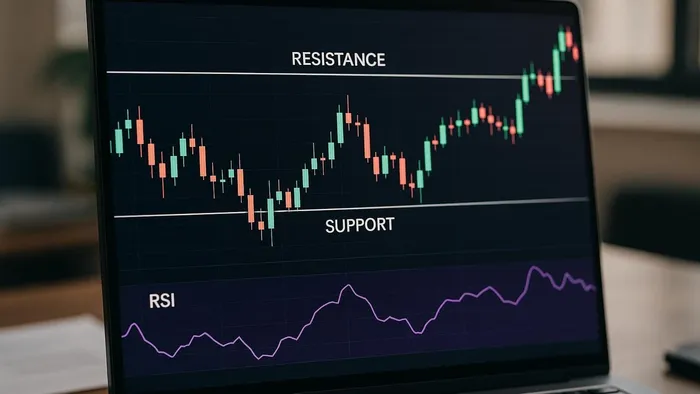Explore five effective RSI trading strategies that leverage support and resistance levels to enhance market entry and exit points.
The Relative Strength Index (RSI) is a tool traders use to spot overbought or oversold conditions in the market. Pairing RSI with support and resistance levels can improve trade entries and exits by identifying key turning points. Here’s a quick breakdown of five strategies that combine RSI with support and resistance:
- RSI Reversal at Support: Look for RSI below 30 near support levels to spot potential buying opportunities. Enter when RSI climbs back above 30.
- RSI Reversal at Resistance: Watch for RSI above 70 near resistance levels. Enter short when RSI drops below 70 and the price shows rejection signs.
- RSI Divergence with Support/Resistance: Use divergence (price and RSI moving in opposite directions) at key levels to predict reversals.
- RSI Breakout Confirmation: Enter when RSI aligns with price breaking through support or resistance, confirming strong momentum.
- RSI Range Trading: Buy near support when RSI is below 30 and sell near resistance when RSI is above 70 in sideways markets.
Each strategy works best in specific market conditions, such as ranging or trending markets. Proper risk management—like setting stop-losses and targeting at least a 2:1 risk-reward ratio—is essential for success. These methods can help traders refine their timing and improve decision-making.
How to Use Support & Resistance Levels with RSI for Profitable Currency Trading
1. RSI Reversal at Support
The RSI reversal at support strategy combines oversold RSI readings (below 30) with confirmed support levels to identify potential buying opportunities. It’s about spotting where price support aligns with weakening momentum, signaling a possible turning point.
Entry Criteria
The setup begins when the RSI dips below 30 and the price approaches a well-established support level—one tested at least twice and showing signs of bouncing or consolidating.
The key is timing your entry. Wait until the RSI starts climbing out of oversold territory while the price holds firm above the support level. The ideal moment to act is when the RSI crosses back above 30, indicating that selling pressure is easing. During this phase, the price should stay above the support level.
Volume plays a critical role in strengthening the signal. Look for a pattern where volume decreases as the price nears support, followed by an increase in volume as the RSI recovers. This shift suggests sellers are losing steam and buyers are stepping in. For a concise primer on how volume reflects participation, see what trading volume represents.
Confirmation Signals
To confirm the reversal, watch for bullish divergence—a scenario where the price makes a lower low at support, but the RSI forms a higher low. Additionally, reversal candlestick patterns like hammers, dojis, or bullish engulfing candles at the support level offer further validation. You can also review a neutral overview of the bullish engulfing pattern for context.
Risk Management Approach
Risk management is essential for this strategy. Place a stop loss 1–2% below the support level to cap potential losses.
Position sizing is equally important. Adjust your trade size so that the total risk from entry to stop loss doesn’t exceed 1–2% of your account balance.
For profit targets, aim for previous resistance levels or use a risk-reward ratio of at least 2:1. If the support level is part of a broader range, consider taking profits near the middle or upper boundary of that range.
Ideal Market Conditions
This strategy works best in ranging markets where support and resistance levels are well-defined and respected.
Focus on medium to higher timeframes—like 4-hour, daily, or weekly charts. These timeframes filter out short-term market noise and highlight more reliable support levels.
It’s especially effective with established stocks or major currency pairs that have a history of respecting technical levels. These assets tend to behave more predictably compared to highly volatile or thinly traded instruments.
Next, we’ll dive into a complementary strategy that focuses on overbought conditions at resistance levels.
2. RSI Reversal at Resistance
An RSI reversal at resistance focuses on identifying overbought conditions (RSI above 70) near established resistance levels. This signals a potential selling opportunity when momentum begins to weaken.
Entry Criteria
Look for the RSI exceeding 70 while the price approaches a resistance level that has been tested and confirmed by at least two prior rejections or consolidations.
The entry signal appears when the RSI starts to decline from overbought territory, and the price struggles to break through the resistance. The ideal moment to enter is when the RSI dips back below 70, indicating a loss of buying pressure. At this point, the price should either remain below the resistance level or show clear signs of rejection.
Volume plays a crucial role here. A spike in volume near resistance, especially during price rejection, suggests strong selling interest as buyers fail to push the price higher.
Confirmation Signals
Bearish divergence strengthens the setup. If the price makes a higher high at resistance while the RSI forms a lower high, it indicates waning upward momentum.
Reversal candlestick patterns like shooting stars, bearish engulfing patterns, or doji formations offer additional confirmation by signaling hesitation or rejection at the resistance level. For a quick refresher, see bearish engulfing pattern basics.
A further signal of reversal is when the price breaks below a recent minor support level, accompanied by the RSI dropping under 70. This shift suggests sellers are gaining control, reinforcing the likelihood of a downward move and supporting a short position.
Risk Management Approach
To manage risk, place a stop loss 1–2% above the resistance level. This limits potential losses if the price unexpectedly breaks out instead of reversing.
Keep your position size in check to ensure no more than 1–2% of your account is at risk. This approach safeguards your capital against false signals.
Set profit targets at previous support levels or aim for at least a 2:1 risk-reward ratio. In range-bound markets, consider taking profits near the lower boundary or mid-range, depending on the strength of the rejection signal.
For added precision, traders can use advanced capabilities LuxAlgo provides on TradingView to automatically detect key resistance levels and RSI reversal signals.
3. RSI Divergence with Support and Resistance Levels
Building on the reversal strategies mentioned earlier, divergence analysis focuses on subtle momentum shifts, offering sharper entry points. RSI divergence occurs when price movement and momentum (as measured by RSI) are out of sync—especially at key support or resistance levels—signaling potential reversals.
Bullish divergence happens when the price forms a lower low but the RSI creates a higher low, hinting at weakening downward momentum. Conversely, bearish divergence occurs when the price reaches a higher high but the RSI registers a lower high, suggesting the upward momentum is losing steam. These patterns, aligned with tested support or resistance levels, can highlight strong entry opportunities.
Entry Criteria
- Bullish divergence: Look for a long entry when the price touches a tested support level, and the RSI forms a higher low. Wait for confirmation through a bullish reversal candlestick pattern.
- Bearish divergence: Consider a short entry when the price struggles at a tested resistance level and the RSI shows a lower high. Enter once the price starts to retreat from the resistance zone.
Combining these setups with clear price and volume signals can boost accuracy.
Confirmation Signals
To confirm a setup, watch for price action and volume cues:
- A volume spike during divergence strengthens the case for a reversal.
- Reversal candlestick patterns—like hammers, engulfing candles, or dojis—at the support or resistance levels add further validation.
- Checking multiple timeframes can improve confidence. For example, if divergence is visible on both 4-hour and daily charts, it tends to be more reliable.
Risk Management Approach
- Set a stop-loss just below the support (for bullish scenarios) or above the resistance (for bearish scenarios). For general mechanics, see how stop-loss orders work.
- Aim for the next key price level with a risk-reward ratio of 2:1.
- Limit risk exposure to 1–2% of your account per trade.
For added precision, advanced traders can use tools like LuxAlgo's Oscillator Matrix (OSC), which detects divergences in real time and highlights critical support and resistance levels. Additionally, LuxAlgo's AI Backtesting Assistant helps refine and test divergence strategies across various assets and timeframes.
4. RSI Breakout Confirmation at Key Levels
Reversal strategies focus on price rebounding off support and resistance levels, but breakout confirmation takes a different approach. It leverages momentum to profit when prices break through established levels with significant force. This method builds on the reversal and divergence techniques discussed earlier, but instead of anticipating a reversal, it confirms the breakout. RSI plays a crucial role here, helping to validate the strength of the move and signaling a shift in market behavior.
Entry Criteria
For bullish breakouts, consider entering a long position when the price closes above a well-established resistance level and the RSI moves above 70 or shows strong upward momentum from the 50 level. For bearish breakouts, enter short when the price closes below a tested support level and the RSI drops below 30 or demonstrates strong downward momentum from the 50 level. The key is that the RSI should align with the direction of the breakout, providing a clear and disciplined entry signal.
Confirmation Signals
Combining RSI with other momentum indicators can enhance the reliability of breakout trades. For example, when RSI breakout signals align with a MACD bullish crossover and price action stays above rising moving averages, the setup becomes more dependable. If you need a primer on MACD itself, see how MACD is calculated and interpreted.
Risk Management Approach
Breakout trades come with the risk of false signals, so strict risk management is essential. Place stop-loss orders just beyond the breakout level (below for longs, above for shorts). Limit your exposure to 1–2% of your account per trade, and use the Average True Range (ATR) to adjust position sizes based on market volatility.
Trailing stops can also be effective, allowing you to lock in profits as the trade progresses. This way, you can capture extended trends while minimizing the risk of giving back gains. For an overview, see what a trailing stop is.
Ideal Market Conditions
Unlike reversal strategies, breakout confirmation thrives in trending markets with well-defined support and resistance zones and moderate to high volatility. These conditions make breakout setups more reliable and can lead to better risk-adjusted returns.
The LuxAlgo Signals & Overlays (S&O) toolkit is particularly helpful for spotting breakout opportunities. Its advanced signal algorithms and overlay visualizations simplify the process of identifying setups. Additionally, the S&O Screener can quickly filter potential breakout candidates across various assets, while the S&O Backtester enables you to test the strategy under different market scenarios.
5. RSI Range Trading Between Support and Resistance
Range trading leverages the predictable price movements between established support and resistance levels. Unlike strategies focused on reversals or breakouts, this approach thrives in sideways markets. By combining RSI with support and resistance analysis, traders can adapt to different market conditions, whether trending or range-bound.
In this strategy, RSI helps pinpoint entry points—buying near support and selling near resistance. It is particularly effective in markets without a clear trend, where prices oscillate within defined channels. During these range-bound periods, RSI’s overbought and oversold signals are especially useful, as prices often reverse after hitting extreme levels.
Entry Criteria
For long trades, wait for the price to approach the support level while RSI dips below 30, indicating oversold conditions. The ideal entry is when the price tests support and RSI confirms oversold levels below 30. For short trades, look for prices nearing resistance with RSI climbing above 70, signaling overbought conditions.
Patience is key—wait for RSI to hit these thresholds before entering. For traders seeking more conservative setups, especially on longer timeframes, using 20/80 RSI levels can increase the likelihood of success.
For example, if a stock trades between a $50.00 support and a $55.00 resistance level, you could enter a long position at $50.20 when RSI drops below 30. Set your target at $54.80 and place a stop-loss at $49.80.
Confirmation Signals
To strengthen your entries, look for confirmation from price action patterns. For instance, a bullish engulfing pattern near support or a bearish engulfing pattern at resistance can signal a potential reversal. See also bullish engulfing and bearish engulfing primers.
Volume spikes near key levels can also validate your trade. A surge in trading activity as the price approaches support or resistance typically reflects stronger market interest. To further refine your timing, consider using additional momentum indicators like moving averages or MACD in conjunction with RSI.
Risk Management Approach
Effective risk management is crucial. Place stop-loss orders just beyond the range boundaries—typically $0.20 to $0.50 outside, depending on the asset’s volatility. Limit your risk to 1–2% of your account equity per trade.
You can also take partial profits as the price approaches the opposite boundary. For example, if you enter a long trade at support with a target at resistance, consider locking in 50% of your profits when the price covers about 75% of the move. This approach secures gains while leaving room for additional upside.
Avoid overtrading in choppy or low-volume markets, as these conditions can lead to false signals and unpredictable price swings, eroding potential profits.
Tools like the LuxAlgo Oscillator Matrix (OSC) can enhance your range trading strategy. With real-time divergence detection and trend-following insights, the OSC Screener identifies assets trading within established ranges. Additionally, the OSC Backtester helps fine-tune RSI settings and risk parameters for various market conditions. This systematic approach reduces guesswork and highlights the most promising range trading setups, complementing the RSI strategies discussed earlier.
Strategy Comparison Table
Each RSI strategy comes with its own set of signals, risk considerations, and ideal scenarios. Here's a quick comparison of five popular RSI strategies, breaking down their entry points, confirmation signals, risk management techniques, and the best market conditions for their application.
| Strategy | Entry Criteria | Confirmation Signals | Risk Management | Best Market Conditions |
|---|---|---|---|---|
| RSI Reversal at Support | RSI drops below 30 at a strong support level | Bullish engulfing candle, hammer pattern, or volume spike at support | Stop-loss below support; target next resistance or 1:2 risk-reward ratio | Range-bound markets, consolidating stocks |
| RSI Reversal at Resistance | RSI rises above 70 at a key resistance level | Bearish engulfing candle, shooting star pattern, or volume spike at resistance | Stop-loss above resistance; target next support or 1:2 risk-reward ratio | Sideways markets, overbought conditions |
| RSI Divergence with S/R | Bullish or bearish divergence at support/resistance | Price forms a lower low while RSI forms a higher low (or vice versa for bearish setups) | Stop-loss beyond recent swing high/low at the divergence point | Trend exhaustion, major turning points |
| RSI Breakout Confirmation | RSI crosses the 50-line as price breaks support/resistance | Strong candle close beyond the level, RSI momentum above/below 50, and volume surge | Stop-loss below breakout candle; aim for a 1:3 risk-reward ratio | Trending markets, high-volatility periods |
| RSI Range Trading | RSI below 30 at support OR above 70 at resistance | Consistent RSI oscillation between 30 and 70, with touches at range boundaries | Stop-loss outside range boundary; take profit at the opposite edge | Consolidating markets, low-trend environments |
Key Takeaways for Strategy Selection
-
Win Rates and Risk-Reward Ratios:
Reversal strategies at support and resistance often achieve win rates of 60–65% with a 1:2 risk-reward ratio. Breakout confirmation strategies, on the other hand, tend to have slightly lower win rates of 55–60%, but they offer a higher 1:3 risk-reward ratio. -
Market Timing Matters:
Sideways markets are ideal for reversal and range trading strategies, while breakout confirmation strategies thrive in trending markets with clear momentum. Divergence strategies shine during transitions, signaling potential trend reversals. -
Conservative vs. Aggressive Approaches:
For those who prefer a more cautious approach, RSI reversal strategies provide relatively predictable results, especially when supported by volume confirmation. Aggressive traders might gravitate toward breakout strategies, which can yield larger gains but demand precise execution and strict stop-loss discipline. -
Position Sizing:
Adjust your position size based on the strategy's risk profile. Range trading often allows for larger positions due to well-defined boundaries, while breakout strategies may require smaller positions to account for higher volatility and the possibility of false signals.
Conclusion
The RSI, when combined with support and resistance levels, helps filter out false signals, leading to more precise entry and exit points. Adding confirmation signals to validate RSI readings can further minimize noise and improve decision-making.
It's important to prioritize risk management, as markets can stay overbought or oversold longer than anticipated. Use tools like stop-loss orders, proper position sizing, and avoid taking on excessive leverage to protect your capital.
Different RSI strategies work better under specific market conditions. For example, reversal strategies are effective in range-bound markets, breakout confirmations suit trending markets, and divergence setups are useful for identifying potential turning points.
To fine-tune these strategies, consider using backtesting and advanced trading tools. LuxAlgo's AI Backtesting Assistant can help optimize RSI strategies across various timeframes. The Oscillator Matrix toolkit provides real-time divergence detection and trend-following insights, while the screeners assist in pinpointing setups that align with your RSI and support/resistance criteria.
FAQs
What are the ideal market conditions for using the RSI strategies with support and resistance?
The RSI strategies described here are most effective in range-bound markets, where prices consistently fluctuate between distinct support and resistance levels. This environment allows the RSI to better pinpoint overbought and oversold conditions, giving traders clearer signals for potential entry and exit points.
When markets have clearly defined support and resistance zones, the reliability of RSI signals improves significantly. Pairing RSI with these levels can help confirm reversals or strengthen trade setups. This indicator shines in consolidating or sideways markets, where price movements are steadier and easier to anticipate.
How does volume confirm RSI signals, and how can it improve my trading strategy?
When it comes to confirming RSI signals, volume plays an essential role as it shows the level of market activity. If the RSI points to overbought or oversold conditions, a noticeable rise in volume can back up the price movement, giving the signal more weight.
For a sharper trading approach, pay attention to volume spikes during RSI divergences or breakouts. These spikes can highlight stronger, more trustworthy signals while helping you avoid misleading ones. By pairing RSI with volume analysis, you can fine-tune your timing for entries and exits, making your trades more precise.
How does using RSI for reversal strategies differ from breakout strategies, and what are the risk management implications?
RSI reversal strategies are designed to spot overbought (above 70) or oversold (below 30) conditions, signaling potential trend reversals. These strategies often call for tighter stop-losses because they carry a higher chance of false signals and sudden price swings.
Breakout strategies, however, center around price breaking through key support or resistance levels. These moves are often supported by RSI divergence, which helps confirm momentum. To manage risk, traders might use wider stop-losses to handle false breakouts, but the advantage lies in the potential for clearer, sustained directional trends.
The key difference between these approaches comes down to signal reliability and risk management. Reversal strategies require precise execution and quick adjustments, while breakout strategies emphasize momentum confirmation and a more flexible risk approach.
References
- Relative Strength Index (LuxAlgo)
- Support & Resistance (Dynamic)
- RSI Candlestick Oscillator
- Breakout Detector (Previous MTF High/Low Levels)
- Trending Market Toolkit
- Risk-Reward Ratio vs. Win Rate
- Reversal Candlestick Structure
- Support & Resistance Levels with Breaks
- Ultimate RSI
- Reversal Spotting Made Easy
- Price Action Concepts (PAC)
- Volume Forecasting
- Oscillator Matrix (OSC)
- AI Backtesting Assistant
- Understanding Moving Averages








